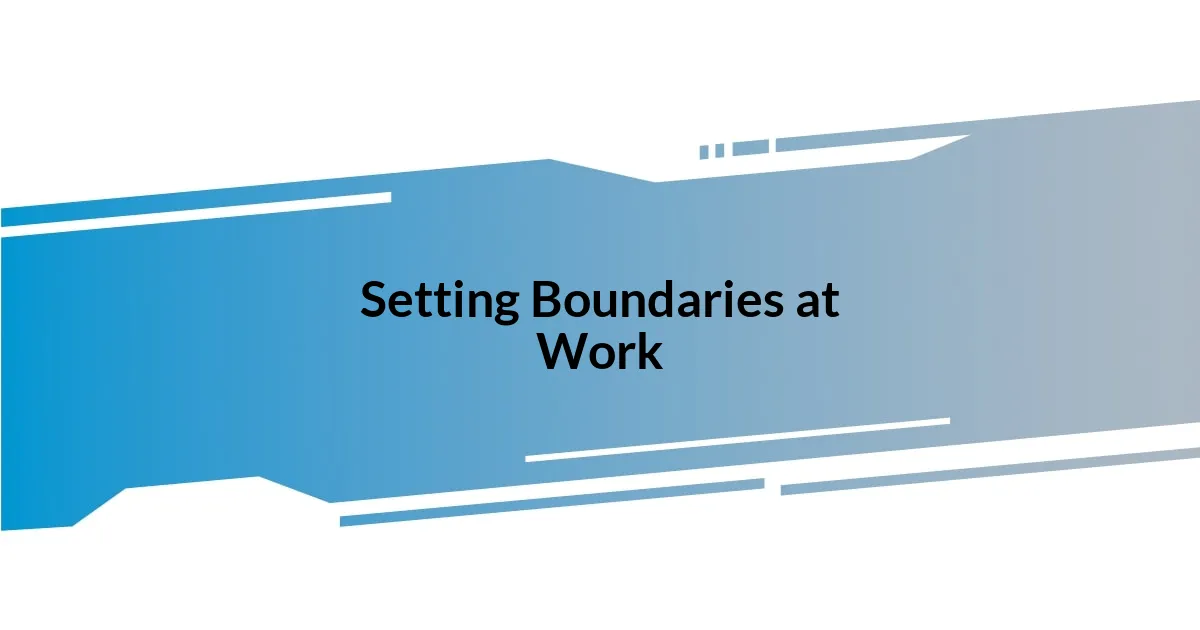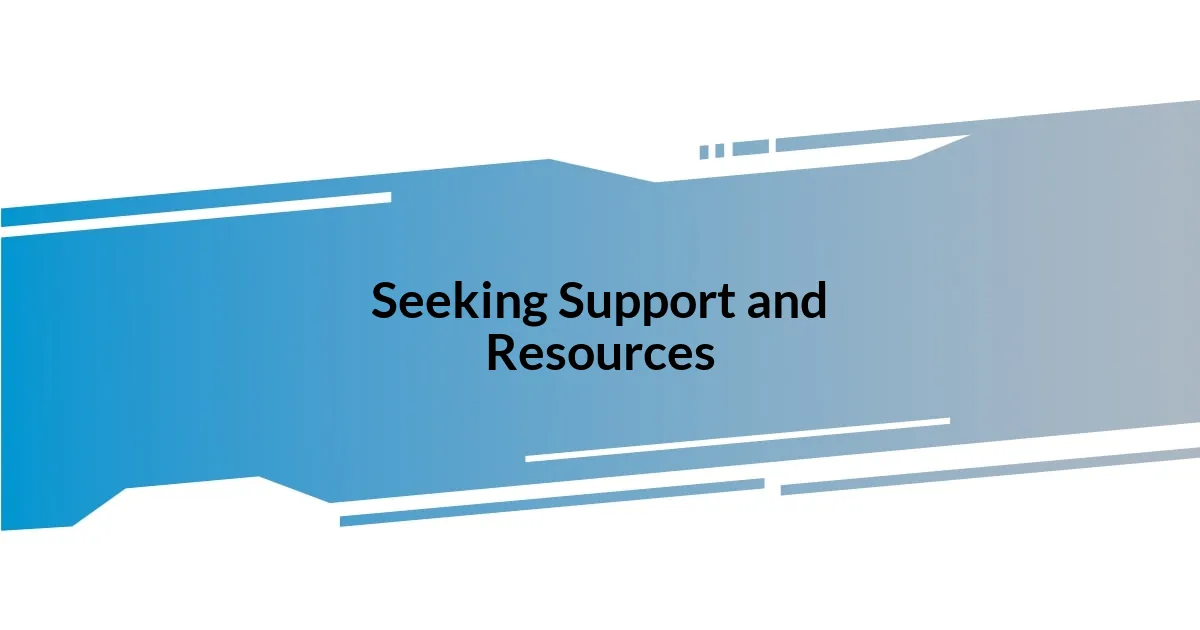Key takeaways:
- Understanding work-family balance involves daily negotiations of priorities and is an ongoing process requiring flexibility.
- Setting boundaries at work improves productivity and protects family time; clear communication and prioritization are essential.
- Creating a family schedule encourages collaboration and spontaneity, strengthening family bonds through shared activities.
- Utilizing time management tools and seeking support from community resources can help manage competing obligations and reduce stress.

Understanding Work Family Balance
Understanding work-family balance is crucial for maintaining overall well-being. I remember a time when I felt pulled in every direction, juggling deadlines and family obligations. It made me question, how can anyone find harmony between these two demanding lives? It’s a compelling thought because the truth is, achieving balance is more about making choices than having it all.
From my experience, work-family balance isn’t a one-size-fits-all concept. It often involves daily negotiations about priorities. For instance, I used to set aside specific weekends for family activities, ensuring that those moments were uninterrupted by emails or work calls. It felt liberating to commit to my loved ones without distractions, opening up space for more meaningful connections.
It’s important to recognize that balance isn’t static; it’s an ongoing process. There are days I feel like I’ve nailed it, and others when I stumble. Picture this: one hectic evening, juggling dinner prep and a deadline, I paused to breathe and asked myself, “What truly matters right now?” This simple act of reflection helped me reorient my priorities and reminded me that flexibility is key in this balancing act.

Identifying Personal Priorities
Identifying personal priorities can sometimes feel overwhelming. I recall a particularly chaotic week where both my project deadline and my child’s school play were scheduled for the same day. It forced me to step back and evaluate what truly mattered to me at that moment—professional obligations or being present for my child. Ultimately, I chose the play, realizing that these little moments shape lasting memories.
There are instances when I reflect on my priorities, and it leads to surprising revelations. For example, during a family meeting, I discovered that my children valued our game nights more than an extra hour I often spent working. It struck me: I had been prioritizing tasks over cherished family rituals that foster connection. Understanding what my family holds dear helped me recalibrate my focus and create a nurturing environment.
Sometimes, it helps to write down personal priorities and visualize what impacts your happiness most. I started making a list of my top three priorities—family time, career goals, and personal well-being. By keeping them visible, I remind myself daily of what deserves my attention. This practice not only keeps me accountable but can also be a gentle nudge when I find myself swaying off-course.
| Priority | Importance |
|---|---|
| Family Time | Building strong bonds and memories |
| Career Goals | Achieving personal and professional fulfillment |
| Personal Well-being | Maintaining mental and physical health |

Setting Boundaries at Work
Setting boundaries at work is an essential skill I’ve cultivated over time. I’ve learned that clearly defining my work hours and unplugging after they end not only protects my family time but also enhances my productivity during work hours. For instance, I used to receive emails late into the evening. Gradually, I communicated to my team that I wouldn’t be available to respond until the next business day. This small shift created a more defined work-life separation, significantly reducing my stress levels.
Here are some effective strategies to help set boundaries at work:
- Establish clear work hours: Communicate your availability to colleagues and stick to it.
- Turn off notifications: Make a habit of disconnecting from work emails and messages after hours.
- Create a dedicated work space: Having a physical boundary can help mentally separate work from home life.
- Learn to say no: Politely decline additional responsibilities that could overwhelm your schedule.
- Schedule breaks: I often take short breaks throughout my workday to recharge and maintain focus.
These practices have been transformative for me, allowing me to engage more fully in both my personal and professional lives without feeling pulled in multiple directions.

Creating a Family Schedule
Creating a family schedule requires thoughtful planning and collaboration. I remember the first time we sat down as a family to create our weekly calendar. The kids were excited, armed with colorful markers, eager to share their activities. This open dialogue not only helped us plot out commitments but also allowed each family member to voice their priorities. Isn’t it amazing how simply including everyone can transform scheduling from a chore into a bonding experience?
As we crafted our schedule, I discovered the importance of flexibility. One week, my husband’s work commitment clashed with my daughter’s soccer practice. Instead of viewing it as an obstacle, we swapped responsibilities, allowing me to attend the game while he tackled the late work hour. This adaptability not only reinforced teamwork but also demonstrated to the kids that unexpected changes can lead to new opportunities. Do you see how a little give-and-take can strengthen family bonds?
I also realized the necessity of making time for spontaneity, an essential element I often overlooked. In our meticulously planned schedules, we began to carve out “family fun” time, those free blocks where we could choose to explore, play games, or just relax together. It was a revelation to see my children light up at the prospect of unstructured fun. Have you tried scheduling in spontaneity? I find it transforms a rigid calendar into a lively adventure that the whole family looks forward to.

Communicating with Family Members
Maintaining open lines of communication with family members is crucial for balancing work and home life. I’ve found that regular check-ins not only keep everyone informed about each other’s schedules but also provide an opportunity to express feelings and concerns. For instance, during our Sunday family dinners, we take turns sharing highlights and lowlights of the week. This practice has brought us closer together, allowing us to understand each other’s pressures and triumphs.
One enlightening moment came when my son confessed he felt neglected because I was often busy with work. It hit me hard, yet it was a wake-up call. I made it a point to dedicate time each evening, even if just for a quick chat or game before bedtime. I realized how simple gestures, like actively listening or showing genuine interest, can significantly impact family dynamics. Can you recall a moment when a small conversation made a world of difference in your own family?
Additionally, I’ve learned about the importance of using technology effectively. Video calls have been a game changer for keeping in touch, especially during hectic work weeks. When my spouse had to travel for work, we started a nightly video call tradition. It was a simple way to connect, ensuring even when physically apart, we remained emotionally close. Have you tried leveraging technology to bridge the gap when life gets busy? It can be a wonderful tool to maintain intimacy and connection amidst the chaos.

Utilizing Time Management Tools
Time management tools have truly revolutionized how I balance my work and family life. Using digital calendars, like Google Calendar, allowed my family and me to color-code our different activities. I remember the first day we imported all our schedules; it felt like opening the floodgates of organization! Now, whenever a new commitment arises, we can immediately see how it fits—or doesn’t—into our lives. Have you ever tried a digital tool that transformed your organization? It can be a game changer!
Another technique I’ve embraced is setting timers for focused work sessions. I started using the Pomodoro Technique, which involves working in bursts of 25 minutes followed by 5-minute breaks. It’s fascinating how this simple structure created a framework that increased my productivity. During those brief breaks, I often sneak in a quick chat with the kids whether it’s helping with homework or just sharing a laugh. Those little moments allow me to reconnect even when my mind is deeply engrossed in work.
Additionally, I’ve come to appreciate task management apps like Todoist. They help me prioritize tasks for work and home, ensuring I don’t overlook anything important. I recall a day when I nearly forgot to buy groceries for dinner. Thanks to my app notification, I was able to squeeze in a grocery run between meetings and still make it back in time for family dinner. Isn’t it a relief when technology gives you that extra nudge to keep life running smoothly? It’s these small conveniences that allow me to maintain balance and reduce the chaos.

Seeking Support and Resources
Seeking support and resources has been a transformative journey for me in balancing family and work. I’ve found that tapping into community resources, like local parenting groups, can be incredibly beneficial. I remember a time when I felt overwhelmed—my kids had overlapping activities, and I was struggling to keep up. Joining a local moms’ network not only provided me with practical advice but also built a support system where we could share carpool duties. Isn’t it amazing how connecting with others can lighten our load?
Professional help can also make a difference. I once explored family therapy when our schedules became chaotic, and it was enlightening. Speaking to a trained counselor helped us navigate our conflicting priorities and emotional stresses. The insights I gained about empathy and communication were invaluable. Have you ever considered reaching out for outside support? Sometimes, a fresh perspective is all it takes to understand and improve family dynamics.
Additionally, self-care resources should never be overlooked. I started utilizing mindfulness apps during my daily commute. Taking just 10 minutes to meditate can shift my mindset entirely. On days when stress levels rise, I reflect on how those moments of stillness help refocus my energy for my family. Have you carved out time for your own mental health? It’s a crucial piece of the puzzle, and I can assure you, when you take care of yourself, everyone around you benefits too.